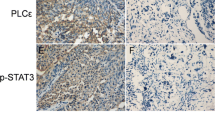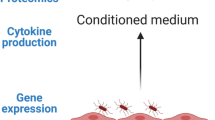Abstract
Akt is linked to both inflammatory and neoplastic pathways. Akt activation is dependent on the phosphatidylinositol-3 kinase (PI3K) signaling pathways. Upon phosphorylation by PI3K, Akt can phosphorylate nuclear factor kappa B (NF-κB) and members of the forkhead family of transcription factors, which includes AFX. Our goal is to examine the effect of Escherichia coli lipopolysaccharide (LPS) on early cellular signaling in inflammatory (NF-κB) and apoptotic pathways (AFX) in a mouse-bladder model and in T-24 urothelial cancer cells. Female C57BL/6 mice were given an intraperitoneal (IP) injection of LPS or LPS free water and sacrificed 0–120 minutes later. Bladders were harvested, and immunohistochemistry (IHC) and/or immunoblotting performed using antibodies to PI3K, inhibitor kappa B-α (IκB-α), and total and phosphorylated Akt, NF-κB and AFX. Levels of IκB-α and total and phosphorylated Akt and NF-κB were determined in T-24 cells treated with LPS for 0–120 minutes. Bladders and T-24 cells were treated with PI3K inhibitors in some experiments. Protein amounts in different samples were normalized to immunoreactive actin. Phosphorylated and non-phosphorylated species of Akt, NF-κB, and AFX were localized to the urothelium. IP LPS injection rapidly (within 30 minutes) increased Akt phosphorylation. IP LPS injection decreased IκB-α levels, and increased NF-κB and AFX phosphorylation. Wortmannin effectively blocked phosphorylation of Akt in LPS-treated mice, and also reduced phosphorylation of AFX and, to a lesser extent, NF-κB. After treatment with LPS, Akt and NF-κB phosphorylation was rapidly increased in T-24 cells. Akt phosphorylation, and to a lesser extent NF-κB phosphorylation, were blocked by LY-294,002. LPS/PI3K/Akt is a cellular signaling pathway which rapidly activates downstream pathways of inflammation and neoplasia in bladder urothelium.






Similar content being viewed by others
Abbreviations
- PI3K:
-
phosphatidylinositol-3 kinase
- NF-κB:
-
nuclear factor kappa B
- LPS:
-
lipopolysaccharide
- IP:
-
intraperitoneal
- IHC:
-
immunohistochemistry
- UTI:
-
urinary tract infection
- TLR:
-
Toll-like receptor 4
- PDK-1:
-
phosphoinositide-dependent kinase-1
- iNOS:
-
inducible nitric oxide synthase
- eNOS:
-
endothelial nitric oxide synthase
- IL:
-
interleukin
- H2O:
-
pyrogen-free water
- IKK:
-
inhibitor kappa B kinase
- IκB:
-
inhibitor kappa B
References
Brownawell AM, Kops GJ, Macara IG, Burgering BM (2001) Inhibition of nuclear import by protein kinase B (Akt) regulates the subcellular distribution and activity of the forkhead transcription factor AFX. Mol Cell Biol 21:3534–3546
Brunet A, Kanai J, Stehn J, Xu D, Sarbessova J, Frangioni V, Dalai, N, Decaprio JA, Greenberg ME, Yaffe MB (2002) 14-3-3 transits to the nucleus and participates in dynamic nucleocytoplasmic transport. J Cell Biol 156 :817–828
Bubenik J, Baresova M, Viklicky V, Jakoubkova J, Sainerova H, Donner J (1973) Established cell line of urinary bladder carcinoma (T24) containing tumour-specific antigen. Internat J Cancer 11:765–773
Burgering BM, Kops GJ (2002) Cell cycle and death control: long live Forkheads. Trends Biochem Sci 27:352–360
Cantley LC (2002) The phosphoinositide 3-kinase pathway. Science 296 :1655–1657
Coussens LM, Werb Z (2002) Inflammation and cancer. Nature 420:860–867
Fitzgerald KA, Bowie AG, Sheehy Skeffington B, O’Neill LAJ (2000) Ras, protein kinase C, and IB kinases 1 and 2 are downstream effectors of CD44 during the activation of NF-B by hyaluronic acid fragments in T-24 carcinoma cells. J Immunol 164:2053–2063
Foxman B (2002) Epidemiology of urinary tract infections: incidence, morbidity, and economic costs. Amer J Med 113:5S–13S
Funfstruck R, Franke S, Helberg M, Ott U, Knofel B, Straube E, Sommer M, Hacker J (2001) Secretion of cytokines by uroepithelial cells stimulated by Escherichia coli and citrobacter spp.. Internat J Antimicro Agents 17:253–259
Graff JR, Konicek BW, McNulty AM, Wang Z, Houck K, Allen S, Paul JD, Hbaiu A, Goode RG, Sandusky GE, Vessella RL, Neubauer BL (2000) Increased AKT activity contributes to prostate cancer progression by dramatically accelerating prostate tumor growth and diminishing p27Kip1 expression. J Biol Chem 275 :24500–24505
Gustin JA, Ozes ON, Akca H, Pincheira R, Mayo LD, Li Q, Guzman JR, Korgaonkar CK, Donner DB (2004) Cell type-specific expression of the IkappaB kinases determines the significance of phosphatidylinositol 3-kinase/Akt signaling to NF-kappa B activation. J Biol Chem 279:1615–1620
Kang WS, Tamarkin FJ, Wheeler MA, Weiss RM (2004) Rapid up-regulation of endothelial nitric-oxide synthase in a mouse model of Escherichia coli lipopolysaccharide-induced bladder inflammation. J Pharmacol Exper Thera 310:452–458
Kops GJ, Medema RH, Glassford J, Essers MA, Dijkers PF, Coffer PJ, Lam EW, Burgering BM (2002) Control of cell cycle exit and entry by protein kinase B-regulated forkhead transcription factors. Mol Cell Biol 22:2025–2036
Li X, Tupper JC, Bannerman DD, Winn RK, Rhodes CJ, Harlan JM (2003) Phosphoinositide 3 kinase mediates toll-like receptor 4-induced activation of NF-kappa B in endothelial cells. Infec Immun 71:4414–4420
Lietzke SE, Bose S, Cronin T, Klarlund J, Chawla A, Czech MP, Lambright DG (2000) Structural basis of 3-phosphoinositide recognition by pleckstrin homology domains. Mol Cell 6:385–394
Liu J, Babaian DC, Liebert M, Steck PA, Kagan J (2000) Inactivation of MMAC1 in bladder transitional-cell carcinoma cell lines and specimens. Mol Carcin 29:143–150
Nicholson KM, Anderson NG (2002) The protein kinase B/Akt signalling pathway in human malignancy. Cell Signal 14:381–395
Olsson LE, Wheeler MA, Sessa WC, Weiss RM (1998) Bladder instillation and intraperitoneal injection of Escherichia coli lipopolysaccharide up-regulate cytokines and iNOS in rat urinary bladder. J Pharmacol Exper Ther 284:1203–1208
Poljakovic M, Svensson ML, Svanborg C, Johansson K, Larsson B, Persson K (2001) Escherichia coli-induced inducible nitric oxide synthase and cyclooxygenase expression in the mouse bladder and kidney. Kidney Int 59:893–904
Saban MR, Hellmich H, Nguyen NB, Winston J, Hammond TG, Saban R (2001) Time course of LPS-induced gene expression in a mouse model of genitourinary inflammation. Physiol Genome 5:147–160
Scheid MP, Marignani PA, Woodgett JR (2002) Multiple phosphoinositide 3-kinase-dependent steps in activation of protein kinase B. Mol Cell Biol 22:6247–6260
Sizemore N, Leung S, Stark GR (1999) Activation of phosphatidylinositol 3-kinase in response to interleukin-1 leads to phosphorylation and activation of the NF-kappaB p65/RelA subunit. Mol Cell Biol 19:4798–4805
Staal SP, Hartley JW, Rowe WP (1977) Isolation of transforming murine leukemia viruses from mice with a high incidence of spontaneous lymphoma. Proc Natl Acad Sci USA 74:3065–3067
Tak PP, Firestein, GS (2001) NF-kappa B: a key role in inflammatory diseases. J Clin Invest 107:7–11
Takeda K, Akira S (2005) Toll-like receptors in innate immunity. Internat Immunol 17:1–14
Theodorescu D (2003) Phosphoinositide signaling in urological disease. J Urol 169:2394–2396
Toker A, Newton AC (2000) Cellular signaling: pivoting around PDK-1. Cell 103:185–188
Wang XC, Saban R, Kaysen JH, Saban MR, Allen PL, Benes EN, Hammond TG (2000) Nuclear factor kappa B mediates lipopolysaccharide-induced inflammation in the urinary bladder. J Urol 163:993–998
Wheeler MA, Yoon JH, Olsson LE, Weiss RM (2001) Cyclooxygenase-2 protein and prostaglandin E2 production are up-regulated in a rat bladder inflammation model. Eur J Pharmacol. 417:239–248
Wheeler MA, Hausladen DA, Yoon JH, Weiss RM (2002) Prostaglandin E2 production and cyclooxygenase-2 induction in human urinary tract infections and bladder cancer. J Urol 168:1568–1573
Wu X, Obata T, Khan Q, Highshaw RA, De Vere White R, Sweeney C (2004) The phosphatidylinositol-3 kinase pathway regulates bladder cancer cell invasion. BJU Int 93:143–150
Zhang D, Zhang G, Hayden MS, Greenblatt MB, Bussey C, Flavell RA, Ghosh S (2004) A toll-like receptor that prevents infection by uropathogenic bacteria. Science 303:1522–1526
Acknowledgement
This research was supported in part by a grant from the Interstitial Cystitis Society.
Author information
Authors and Affiliations
Corresponding author
Rights and permissions
About this article
Cite this article
Tamarkin, F.J., Kang, W.S., Cohen, J.J. et al. A role for Akt in the rapid regulation of inflammatory and apoptotic pathways in mouse bladder. Naunyn-Schmied Arch Pharmacol 373, 349–359 (2006). https://doi.org/10.1007/s00210-006-0081-2
Received:
Accepted:
Published:
Issue Date:
DOI: https://doi.org/10.1007/s00210-006-0081-2




